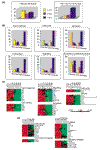Genomic-scale measurement of mRNA turnover and the mechanisms of action of the anti-cancer drug flavopiridol
- PMID: 11597333
- PMCID: PMC57796
- DOI: 10.1186/gb-2001-2-10-research0041
Genomic-scale measurement of mRNA turnover and the mechanisms of action of the anti-cancer drug flavopiridol
Abstract
Background: Flavopiridol, a flavonoid currently in cancer clinical trials, inhibits cyclin-dependent kinases (CDKs) by competitively blocking their ATP-binding pocket. However, the mechanism of action of flavopiridol as an anti-cancer agent has not been fully elucidated.
Results: Using DNA microarrays, we found that flavopiridol inhibited gene expression broadly, in contrast to two other CDK inhibitors, roscovitine and 9-nitropaullone. The gene expression profile of flavopiridol closely resembled the profiles of two transcription inhibitors, actinomycin D and 5,6-dichloro-1-beta-D-ribofuranosyl-benzimidazole (DRB), suggesting that flavopiridol inhibits transcription globally. We were therefore able to use flavopiridol to measure mRNA turnover rates comprehensively and we found that different functional classes of genes had distinct distributions of mRNA turnover rates. In particular, genes encoding apoptosis regulators frequently had very short half-lives, as did several genes encoding key cell-cycle regulators. Strikingly, genes that were transcriptionally inducible were disproportionately represented in the class of genes with rapid mRNA turnover.
Conclusions: The present genomic-scale measurement of mRNA turnover uncovered a regulatory logic that links gene function with mRNA half-life. The observation that transcriptionally inducible genes often have short mRNA half-lives demonstrates that cells have a coordinated strategy to rapidly modulate the mRNA levels of these genes. In addition, the present results suggest that flavopiridol may be more effective against types of cancer that are highly dependent on genes with unstable mRNAs.
Figures







References
-
- Alizadeh AA, Eisen MB, Davis RE, Ma C, Lossos IS, Rosenwald A, Boldrick JC, Sabet H, Tran T, Yu X, et al. Distinct types of diffuse large B-cell lymphoma identified by gene expression profiling. Nature. 2000;403:503–511. - PubMed
-
- Bittner M, Meltzer P, Chen Y, Jiang Y, Seftor E, Hendrix M, Radmacher M, Simon R, Yakhini Z, Ben-Dor A, et al. Molecular classification of cutaneous malignant melanoma by gene expression profiling. Nature. 2000;406:536–540. - PubMed
-
- Perou CM, Sorlie T, Eisen MB, van de Rijn M, Jeffrey SS, Rees CA, Pollack JR, Ross DT, Johnsen H, Akslen LA, et al. Molecular portraits of human breast tumours. Nature. 2000;406:747–752. - PubMed
-
- Carlson B, Pearlstein R, Naik R, Sedlacek H, Sausville E, Worland P. Inhibition of CDK2, CDK4 and CDK7 by flavopiridol and structural analogs. Proc Am Assoc Cancer Res. 1996;37:424.
MeSH terms
Substances
LinkOut - more resources
Full Text Sources
Other Literature Sources

